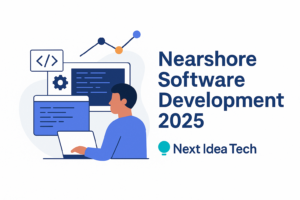The global SaaS market has experienced tremendous growth during the last couple of years. As of 2022, the software as a service industry has a value of over $170 billion and increased its size by approximately 500% over the past seven years.
Hire the best developers in Latin America. Get a free quote today!
Contact Us Today!This shows the tremendous business potential and cost of building SaaS, and why many companies decide to venture into this industry to generate or increase their revenue.
Now, while a SaaS application can help bring in a sizeable income, there’s also a considerable cost. Building a SaaS product is a serious financial commitment and requires proper planning and a solid budget.
But to be able to plan and settle on a budget, you need to have a clear understanding of the true cost of building SaaS and where all the hidden expenses start to add up. Today’s article is an ultimate guide on what costs to consider to build a SaaS app!
What is SaaS?
SaaS stands for Software As A Service – a way to deliver applications through the internet to users worldwide. SaaS products are easy to navigate, available with any web browser, and hosted by a cloud provider.
There are essentially two types of SaaS applications: web apps available from any internet browser and mobile SaaS apps downloaded into the user’s phones. These SaaS products can be built using different methods, but we always recommend the methodologies of Agile development.
As seen by recent statistics, several companies require SaaS services and use them to grow their businesses. There are two options when it comes to Saas. The first one is to start a SaaS-based business from scratch, starting with an innovative idea.
The second reason or way to build a SaaS app is as an expansion strategy for your current business, adding a technological value proposition for your customers to increase both leads and overall sales. Whichever option you choose, there is a cost to building SaaS, and that’s what we’re here to breakdown today.
What elements make up the true cost of building SaaS?
The expectations and scope of your SaaS app.
The scope of your SaaS development project is the single most influential factor when it comes to the cost of building SaaS.
There are different kinds of software as a service products your company can plan on building, and they will make the process a lot less or more expensive depending on their individual features.
Though the broad divide of SaaS products only has two main types of software as a service projects, which are explained below.
- SaaS tools:
Software as a service tools are simple applications that have one, two, or three main functionalities available to their users. These are applications used with a very specific purpose and that most people won’t access all the time.
Users open the app, select the feature they wish to take advantage of, use it, and move on to the next thing on their to-do list.
They usually help on a certain area of someone’s day or business needs and that’s it, which is why they involve considerably fewer development hours and are the cheapest way to build SaaS without resulting in a poorly functioning app.
A popular example of a SaaS tool that truly makes everyone’s life easier is Calendly. This software as a service tool is simple to use and available on any web browser with an internet connection. Its main functionality? Virtual meeting logistics.
Through a simple link, anyone can see someone’s calendar and schedule a call for the most convenient time. It’s a straightforward tool that many people use and isn’t as complex to develop as building a SaaS platform.
- SaaS platforms:
Now onto the more complex kind of software as a service project. SaaS platforms are usually fully featured and include several different functionalities users can take advantage of. Most SaaS platforms have both web and mobile applications available and allow users to perform multiple tasks or solve different needs through their software.
These are much more expensive to develop because of the broader scope of their development project. You can expect your development team to work on SaaS platforms for a lot more hours than if they build SaaS tools.
The easiest example of software as a service platform is Slack. This platform is used by people from all over the world to solve their remote work needs and improve team communication and collaboration.
Through a wide range of features, like chats, Google Docs integrations, and customizable channels, Slack helps businesses manage their remote development teams and facilitates communication between distributed team members.
Slack is considered a SaaS platform instead of a tool thanks to the varied suite of features it offers and how easy is to spend hours interacting with others in the app.
Cloud services:
Platform evaluation is a usual part of any software development lifecycle. Still, when it comes to building a SaaS app, there’s a stronger focus on the cloud provider/services.
This is because the entire software as a service business model it’s based on a cloud delivery system – meaning that if your cloud platform isn’t solid, neither will be your app’s performance.
Cloud services can truly impact the cost of building SaaS, with different options depending on your budget and preferred features.
This is a sensible choice that needs to be made alongside a team of SaaS developers, cloud architects, and business analysts, so make sure to take a thorough look at the functionalities of each cloud platform instead of only focusing on the price.
Built-in systems:
There are many components to a SaaS application. These are different systems within the overall system that allow users to do things like switching pricing plans, receiving purchase orders via emails, allowing or denying cookies, and managing their profile.
These systems need to be built within your SaaS platform or tool and all come at a price. The cost of building SaaS systems for a project will depend on the number of hours each feature takes to develop, but they need to be taken into account when planning the budget.
- Transactional emails
- Permission systems
- User management system
- Pricing plans
Test building.
Building tests into the SaaS system will help your business grow faster in the long term since a premade user interface allows products to run smoother.
Once you have an established user base, there won’t be a need to keep running tests for potential improvements or disaster recoveries – all the necessary data will already be there for your development team to assess and solve most scenarios.
Security.
Cybersecurity is no joke when it comes to software as a service products. Because users are constantly accessing the web to use these applications, many hackers will try to get into your servers and steal personal information.
This is why you need to build a top-notch security system into your app or hire additional security to prevent hackers from accessing your software as a system application.
Marketing and release.
The work isn’t over once your developers have finished building the software as a service application. Before the official deployment to all users, your company’s marketing and social media teams should work on an efficient marketing strategy to promote the app to as many potential clients as possible.
This can be quite costly depending on the reach of your campaign and your marketing budget.
- User testing
- Advertising campaigns
- Social media marketing
- Press releases
Stages of the SaaS development lifecycle and their hourly estimates
1. Envisioning:
As the name suggests, this is the stage of software as a service where companies determine the vision and scope of the project. While this is only the first step, it’s important to involve relevant team members in this process, such as investors, stakeholders, department managers, sales directors, and business analysts.
This is where you create the idea for your SaaS application and identify the business needs and opportunities, conduct market research, and assess different strategic plans. You can expect this phase to take between 20 hours to build a SaaS tool that’s simple to create and 50+ hours for complex SaaS platforms.
2. Platform evaluation:
Evaluating which cloud service will be the foundation of your software as a service product is no easy task. When budgeting the cost of building SaaS, it might be tempting to use a cheaper cloud service platform from the get-go, but this could cause your SaaS app trouble in the long term.
This is why the stage of platform evaluation in the SaaS development life cycle is a crucial step that shouldn’t be rushed. To get started, developers and cloud architects will need to deliver different system roadmaps, migration processes, solution ecosystems, and developer content. Overall, evaluation can take anywhere from 30 hours to 80+ hours.
3. Planning:
The planning stage consists of making the right decision when creating the business plan for your software as a service project. Now that you have the vision, scope, and cloud platform of your future SaaS application, it’s time to plan and anticipate the different deadlines, deliverables, and tracking methods that will be needed in the future.
Planning truly is one of the most extensive stages, with its hourly estimates ranging from 40 to 100+ hours depending on the size of your software as a service project. A poor performance during this stage can end up increasing the cost of building SaaS in the future, so it’s best to ensure every step is handled properly.
4. Subscription model:
Now that you know the scope of your SaaS application, you have struck a deal with your preferred cloud infrastructure, and you have planned everything that was needed to start building SaaS, your company can officially begin a subscription with your cloud provider.
While setting up a cloud service subscription shouldn’t take much of your time, you should still allow for this stage to take between 10 and 30+ hours of work.
5 Developing:
The development stage when building SaaS is probably the most important yet stressful and time-consuming part of the process. This is where you need to have a talented team of experienced SaaS developers to bring your project vision to life.
There’s usually the first iteration to build the first iteration of the software as a service application, followed by other iterations where additional features, updates, and improvements are added to the software.
Don’t be surprised if the developing stage of building a SaaS product takes months and severely increases the cost of building SaaS. The SaaS development phase can take anywhere between 100 and 500+ hours.
6. Operation:
The final stage of the software as a service lifecycle is operation, where the main task is to deploy and maintain your newly built SaaS application.
This is when your team will need to finalize the support plan, integrate the app into the cloud, plan the deployment, conduct backups and set up a disaster recovery measure, monitor the performance, and gather data to analyze the first few weeks of the new app.
The beginning of the operation stage (until deployment) can take somewhere between 20 and 40+ hours, while the rest of this phase will most likely take longer, with some tasks like maintenance being regularly repeated.
Are you looking for talented remote developers to build a SaaS application?
At Next Idea Tech, we understand that finding the perfect team of remote developers can be a challenge, especially if you’re new to IT staff augmentation and remote hiring. Still, as we’ve explored in this post, the cost of building SaaS can quickly escalate to higher budgets if you don’t start looking for cheaper alternatives to the elements that most affect it.
That’s why we offer US companies looking to build SaaS products the opportunity to hire nearshore software developers from Latin America and all over the world to reduce their development costs and form the right remote IT team. Contact us today to learn more about our services!




